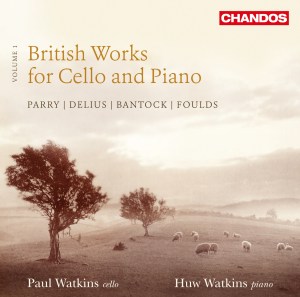 |
 |
|


alternatively
CD: MDT
AmazonUK
AmazonUS
Download
from The Classical Shop
|
British Works for Cello and Piano: Volume 1
Charles Hubert Hastings PARRY
(1848-1918)
Sonata for Cello and Piano in A major (1879-80, revised 1883) [26:31]
Frederick DELIUS (1862-1934)
Sonata for Cello and Piano (1916) [13:10]
Granville BANTOCK (1868-1946)
Hamabdil - Hebrew Melody (1919) [5:40]
John FOULDS (1880-1939)
Sonata for Cello and Piano, Op.6 (1905, revised 1927) [24:33]
 Paul Watkins (cello) Huw Watkins (piano)
Paul Watkins (cello) Huw Watkins (piano)
rec. Potton Hall, Dunwich, Suffolk, 5 -6 April (Delius, Foulds,
Bantock) and 5 June (Parry) 2012
 CHANDOS CHAN10741 [69:58]
CHANDOS CHAN10741 [69:58]
|
|
|
A great place to start the exploration of this excellent new
CD of cello and piano music is with Granville Bantock’s
beautiful Hamabdil. The work originated as an entr’acte
to Arnold Bennett’s play Judith (1919) which was
based on the well-known story from the Apocryphal Old Testament.
In the same year, the music was worked up into at least three
versions including one for Cello Solo, Strings, Kettledrum and
Harp (or Piano) and the present arrangement for Cello and piano
(or harp) (Dutton;
Lowri).
This short piece is based on a Hebrew melody which is subjected
to a series of ‘continuous variations’. The mood
of Hamabdil is rhapsodic and carries the burden of sadness
that seems to typify much Jewish melody.
Of all the works on this CD the one that I am most at home with
is the gorgeous Sonata by Charles Hubert Hastings Parry. The
first and only time I have heard this work live was when at
the end of a long, but thoroughly enjoyable ‘Parry Day’
at the Royal College of Music. Raphael Wallfisch and Hiroaki
Takenouchi gave a stunning account of the work. At that time
I felt that it was unbelievable that this work was not in the
cello repertoire: I have since heard the excellent performance
by Andrew Fuller and Michael Dussek on Dutton
Epoch CDLX7102.
Parry’s Cello Sonata is a relatively early work, dating
from 1879 when the composer was thirty-one years old. Interestingly,
it was composed the year before the first performance of the
‘mould-breaking’ choral Prometheus Unbound
which has been acclaimed as the moment that British music’s
self-confidence was restored. The present Sonata is written
in three movements with the slow ‘andante sostenuto’
being especially moving and expressive. The opening movement
is constructed in formal sonata form. However, the final movement
has a mysterious introduction before ‘the sun comes out’
and the music becomes much more positive. The work ends with
an impressive coda. Although it is possible to note stylistic
allusions to Brahms and Schumann in much of this Sonata, it
is a remarkable work that reveals the elusive note of Parry’s
‘Englishness’ for the first time.
Most of Delius’s chamber works were composed late in his
career. The present Cello Sonata was written in 1916 and was
premiered by Beatrice Harrison and Hamilton Harty at the Wigmore
Hall on 31 October 1918. The music is expounded in a long single
movement that is separated into three contrasting sections ‘Allegro
ma non troppo’, ‘Lento, molto tranquillo’
and ‘Tempo primo’. There is little relaxation in
this sonata with an almost continuous development of the music
as a long unbroken song. The cello explores the entire compass
of the instrument: the accompanist never has a rest. Delius
chamber works have never gained the popularity of the orchestral
music. This may be due to the more austere nature of much of
the writing. However, this Cello Sonata has considerable warmth
and this makes it approachable to people who may prefer the
orchestral ‘Cuckoo’ and ‘Paradise Garden’.
It is a beautiful work that is ultimately satisfying, even if
it does not quite fit into the Delian mould.
The Guardian Reviewer has noted the five columns of liner-notes
given to the exposition of the John Foulds' Cello Sonata. It
certainly takes a deal of time to read this closely written
text. However I disagree with his assessment of this work as
‘unremarkable’ ‘despite the energy and virtuosity
it demands’. I largely sympathise with the first half
of Malcolm MacDonald’s contention that this ‘remarkably
powerful and original’ sonata is one of the finest, if
not the finest Cello Sonata by an English composer’.
The sonata was composed in 1905 when Foulds was 25 years old.
It was considerably revised for publication in 1927. However
in the 85 years since its publication it appears to have suffered
considerable neglect. Foulds enthusiasts will have the excellent
British Music Society (BMS423CD)
recording with Jo Cole (cello) and John Talbot (piano).
It is not necessary to give an outline of the Sonata’s
structure save to note that it is written in three movements
- ‘Moderato quasi allegretto’, ‘Lento’
and ‘Molto brioso’. The heart of the work is the
middle movement. This is a heart-achingly beautiful elegy. The
Fouldsian fingerprint of ‘quarter tones’ should
not put off the listener: it is not a gimmick, but essential
to the musical argument.
It is useful to recall that John Foulds was the only professional
cellist amongst the composers on this disc. The present Sonata
calls for a significant technical skills from both instrumentalists
to present the sweeping development of this torrentially passionate
and expressive work.
I was hugely impressed by this CD. The two soloists, Paul Watkins
and Huw Watkins respond with great sympathy and understanding
to these diverse pieces. The liner-notes by Calum MacDonald
are considerable and tell the listener virtually all that they
could wish to know about these four pieces. I felt that the
sound quality was excellent and revealed all the musical nuances.
I am delighted that this is Volume 1 of a projected series.
Roll on the next release!
John France
see also review by Michael
Cookson
|
|

